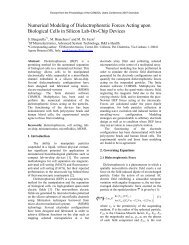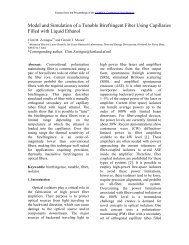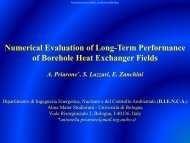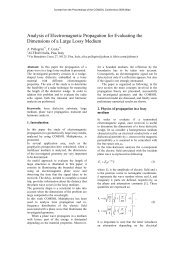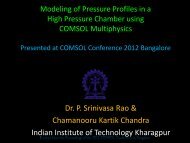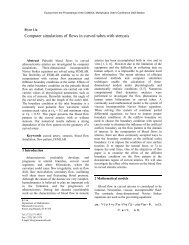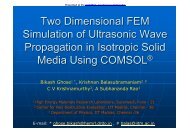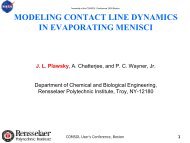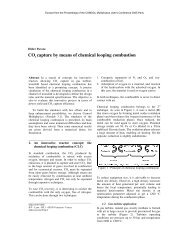Mathematical Modeling of Nanomaterials - COMSOL.com
Mathematical Modeling of Nanomaterials - COMSOL.com
Mathematical Modeling of Nanomaterials - COMSOL.com
Create successful ePaper yourself
Turn your PDF publications into a flip-book with our unique Google optimized e-Paper software.
P<br />
P<br />
Excerpt from the Proceedings <strong>of</strong> the <strong>COMSOL</strong> Multiphysics User's Conference 2005 Frankfurt<br />
<strong>Mathematical</strong> <strong>Modeling</strong> <strong>of</strong> <strong>Nanomaterials</strong><br />
1<br />
D. J. Strauss P<br />
P, C. TrenadoP<br />
2<br />
1<br />
2<br />
PInstitute <strong>of</strong> New Materials, Saarbrücken, Tstrauss@inm-gmbh.deT, P<br />
PInstitute <strong>of</strong> New Materials,<br />
Saarbrücken, Ttrenado@inm-gmbh.deT,<br />
1 Introduction<br />
<strong>Mathematical</strong> modeling at the Institute <strong>of</strong> New Materials has played a crucial role in<br />
supporting the manufacturing and design <strong>of</strong> new technologies <strong>of</strong> nanomaterials, whose<br />
applications range from transportation, electronics and optics engineering to environmental<br />
sciences. In this paper, we focus our attention to two mathematical models together with their<br />
corresponding FEMLAB simulations: The first part <strong>of</strong> the paper is about <strong>com</strong>putational<br />
modeling <strong>of</strong> fire-retardant nano<strong>com</strong>posite gels and the second one deals with Magnetic<br />
nanoparticles for in vivo applications. We provide specific background and numerical results<br />
for each model to finally state conclusions to our modeling.<br />
1.1 Computational <strong>Modeling</strong> <strong>of</strong> Fire-Retardant Nano<strong>com</strong>posite Gels<br />
1.1.1 Background<br />
Fire retardant intumescent materials start to bubble in response to fire and swell into bust<br />
foam. They provide protective coatings through absorption <strong>of</strong> heat by endothermic reactions<br />
and through insulating properties <strong>of</strong> the final structure. Recently, aqueous intumescent<br />
nano<strong>com</strong>posites based on nanoscaled SiO2 particles have been introduced by the Institute<br />
for New Materials and may lead to a significant improvement <strong>of</strong> general fire protective<br />
systems. See Fig. 1 for an application <strong>of</strong> this gel.<br />
A reliable mathematical model representing the heat flow characteristics <strong>of</strong> these materials<br />
does not exist up to now, but it is indispensable for an optimization <strong>of</strong> fire retardant systems<br />
containing this <strong>com</strong>posite. Moreover, such a model might provide a deeper understanding <strong>of</strong><br />
the mechanisms determining the excellent thermal insulating properties <strong>of</strong> the <strong>com</strong>posite and<br />
may thus help to derive optimization objectives. In this study, we present the first macroscale<br />
heat flow model <strong>of</strong> this nano<strong>com</strong>posite. We evaluate our model by using experimental data.<br />
This model might be used for optimizing macroscale parameters <strong>of</strong> fire retardant systems<br />
containing this <strong>com</strong>posite such as the layer thickness, especially, in multilayer arrangements,<br />
and for diverse boundary conditions. Furthermore, chemical manufacture objectives for the<br />
optimal bubble growth and outgassing can be derived from this model. From a modeling<br />
point <strong>of</strong> view, this model is also a prerequisite for a more <strong>com</strong>plex heterogeneous multiscale<br />
modeling framework in which the matrix changes are obtained from an embedded micronanoscale<br />
model. Such a multiscale approach allows for the simulation <strong>of</strong> materials in<br />
arbitrary settings and with extreme and unusual boundary conditions, which in turn impacts<br />
enormously in the experimental cost and material <strong>com</strong>ponent optimization.<br />
In this respect, an evolutionary programming approach can be <strong>com</strong>bined with heterogeneous<br />
multiscale models to obtain application specific parameters for the model by making use <strong>of</strong><br />
unconstraint programming <strong>of</strong> high dimensional hypersurfaces. This notion has been applied<br />
for the optimization <strong>of</strong> the intumescent retardant material which has been developed at the<br />
INM.
Excerpt from the Proceedings <strong>of</strong> the <strong>COMSOL</strong> Multiphysics User's Conference 2005 Frankfurt<br />
Figure 1. The intumescent nano<strong>com</strong>posite gel for the realization <strong>of</strong> retardant windows.<br />
1.1.2 Model description<br />
Our model represents the phase change from a virgin material (the gel) to a porous material<br />
(the final structure with bubble inclusions and after the carbonization <strong>of</strong> the organic<br />
<strong>com</strong>pounds) by a moving mushy front, mainly driven by outgassing. Here we do not consider<br />
a (hard) Heavyside phase front, usually used in problems <strong>of</strong> the Stefan type, which is more<br />
natural from a physical point <strong>of</strong> view. For this, a generalized form <strong>of</strong> the transient heat<br />
equation with a drain term representing the absorption <strong>of</strong> heat by endothermic reactions is<br />
employed.<br />
An additional mass conservation equation is coupled to this heat equation using a<br />
temperature dependent empirical function for the mass loss due to outgassing.<br />
This mass conservation equation is also used to derive the change <strong>of</strong> the porosity<br />
(normalized inverse <strong>of</strong> the density) <strong>of</strong> the material and the effective dynamic thermal<br />
conductivity (according to the Maxwell model).<br />
The dynamic porosity is related to the averaged bubble growth and growth limits are<br />
introduced by taking the stability <strong>of</strong> the bubbles into account. The stability <strong>of</strong> bubbles is<br />
strongly related to the insulating properties <strong>of</strong> the porous phase and the final glass matrix<br />
after the mushy transformation front has passed. The equations are solved in a domain Ω<br />
using the finite element method.<br />
To the derive the unknown empirical parameters as well as to validate the model, a number<br />
<strong>of</strong> experimental measurements were performed in a specially designed high temperature<br />
oven using (mechanically) stiff gel plates with a varying proportion <strong>of</strong> a hardening agent,<br />
which determines the growth and stability <strong>of</strong> bubbles, and different thicknesses <strong>of</strong> the plates.<br />
Genetic programming was applied to fit the model to the experimental data as well as the<br />
boundary conditions, in addition the general model conduction +convection + radiation was<br />
used to determine the free boundary.<br />
1.1.3 Results<br />
Our model provided a high correlation to the oven measurements using 1D and 2D numerical<br />
simulations. In particular, our model allowed for a representation <strong>of</strong> the temperature<br />
gradients in space over time and exhibited a good qualitative correlation in the phase change<br />
behavior, which was analyzed in a different set <strong>of</strong> experiments such as thermo-gravimetric<br />
analysis. The influence <strong>of</strong> the hardening agent was also reflected in the numerical<br />
simulations. In Fig. 2 (left) the outgassing function depending on the temperature is shown<br />
for particular sets <strong>of</strong> parameters. The temperature pr<strong>of</strong>ile at the backside (none heating side)<br />
<strong>of</strong> a stiff gel plate with a thickness <strong>of</strong> 20mm for different outgassing settings which are related<br />
to the proportion <strong>of</strong> hardening agent in the plates is shown Fig. 2 (right). The plateaus in<br />
curve reflect the active insulation properties due to outgassing <strong>of</strong> the aqueous nano<strong>com</strong>posite.
Excerpt from the Proceedings <strong>of</strong> the <strong>COMSOL</strong> Multiphysics User's Conference 2005 Frankfurt<br />
400<br />
Q=1<br />
Q=1.5<br />
350<br />
300<br />
Q=1<br />
Outgassing<br />
Temperature<br />
250<br />
200<br />
150<br />
Q=1.5<br />
100<br />
50<br />
0 100 200 300 400 500<br />
Temperature (°C)<br />
0<br />
0 1000 2000 3000 4000 5000 6000 7000<br />
Time (sec)<br />
Figure 2. Left: the outgassing function over time; Right: the temperature at the insulation side for the<br />
different outgassing settings<br />
1.1.4 FEMLAB <strong>Modeling</strong><br />
The different finite element capabilities <strong>of</strong> FEMLAB were used to deal with the simulation <strong>of</strong><br />
heat transport in the intumescent material. In Fig. 3 we show an investigation <strong>of</strong> the spherical<br />
bubble size to check effective thermal conductivity models <strong>of</strong> porous media, e.g., Maxwell or<br />
Raleigh. Fig. 4 shows two similar <strong>com</strong>posed constructions (steal, copper, and iron letters on<br />
a marble block). The left construction has a layer <strong>of</strong> the INM intumescent nano<strong>com</strong>posite<br />
which provides thermal insulation while the construction on the right is in direct contact to the<br />
heat source. The thermal insulation by the nano<strong>com</strong>posite is clearly noticeable (heating time<br />
approx. 30 min).<br />
Figure 3: Bubble investigation<br />
Figure 4: Two <strong>com</strong>posed constructions<br />
1.1.5 INM measurements used in fitting the numerical model<br />
In Fig. 5 we show the volume <strong>of</strong> the sample in dependence on the temperature (“Härter” -<br />
hardening agent). In Fig. 6 we show the thermal conductivity <strong>of</strong> the solid phase (the<br />
destroyed and trampled down char) in dependence on the temperature.
Excerpt from the Proceedings <strong>of</strong> the <strong>COMSOL</strong> Multiphysics User's Conference 2005 Frankfurt<br />
Figure 5 Figure 6<br />
In Fig. 7 we show the density <strong>of</strong> the sample in dependence on the temperature and for<br />
different proportions <strong>of</strong> the hardening agent. In Fig. 8 we show the loss <strong>of</strong> mass in the<br />
sample in dependence on the temperature and for different proportions <strong>of</strong> the hardening<br />
agent.<br />
Figure 7 Figure 8<br />
1.2 Magnetic nanoparticles for in vivo applications:<br />
A Numerical modeling study<br />
1.2.1 Background<br />
In vivo applications <strong>of</strong> bio<strong>com</strong>patible magnetic nanoparticles in a carrier liquid controlled by<br />
an external magnetic field from outside the body has recently been proposed for specific<br />
drug delivery such as in locoregional cancer therapies or the occlusion aneurysms. They can<br />
also be used as guided contrast agents in myocardial imaging after myocardial infarction.<br />
However, the choice <strong>of</strong> the optimal clinical setting still remains a challenge for every <strong>of</strong> the<br />
mentioned applications. A numerical heterogeneous multiscale model can be used for the<br />
optimal a priori determination <strong>of</strong> the free parameters and might help to over<strong>com</strong>e this<br />
problem. In this study, we are going to present an approach to the implementation <strong>of</strong> such a
Excerpt from the Proceedings <strong>of</strong> the <strong>COMSOL</strong> Multiphysics User's Conference 2005 Frankfurt<br />
multiscale model. We applied a hybrid scheme which is based on Maxwell and Navier-<br />
Stokes equations to paramagnetic liquids with particles <strong>of</strong> the size <strong>of</strong> 10nm (ferr<strong>of</strong>luids). For<br />
a considered area <strong>of</strong> the body, the Maxwell equations for the static magnetic case were<br />
solved. The vector potential was then coupled to a liquid flow problem described by the<br />
Navier-Stokes equations by a volume force acting on the magnetic liquid. Time-dependent<br />
boundary conditions were used to describe the systolic blood flow regime. The system <strong>of</strong><br />
coupled partial differential equations was solved by the finite element method on adaptive<br />
meshes. For a representative geometry which can be extracted by medical imaging, our<br />
hybrid model allowed the study <strong>of</strong> the hydrodynamics <strong>of</strong> the magnetic liquid. Moreover, our<br />
model is open for an embedding <strong>of</strong> a nanoscale model which represents the particle<br />
dynamics. It is concluded that the proposed model is a prerequisite for the optimal<br />
<strong>com</strong>putational choice <strong>of</strong> the free parameters <strong>of</strong> magnetic liquids and the external magnetic<br />
field for in vivo applications.<br />
1.2.2 Model equations<br />
Maxwell‘s Equations for the Static Case:<br />
∇ × H = J ∇ ⋅B = 0<br />
Using a constitutive relation: B = µ ( H + M)<br />
These equations can be <strong>com</strong>bined to:<br />
−1<br />
∇× ( µ ∇× A − M)<br />
= J<br />
Where A denotes a magnetic vector potential, B is the Magnetic Flux density, M the<br />
magnetization vector, J is the current density vector and H is the magnetic field vector.<br />
The magnetization (gamma) <strong>of</strong> the ferr<strong>of</strong>luid is given by<br />
⎛<br />
⎜<br />
⎛ −<br />
γ =<br />
α arctan⎜<br />
βµ<br />
⎝ ⎝<br />
1<br />
∂A ( x,<br />
y)<br />
⎞ ⎛ ∂ ⎞⎞<br />
−1<br />
A(<br />
x,<br />
y)<br />
⎟,<br />
α arctan⎜<br />
βµ ⎟⎟<br />
∂x<br />
⎠<br />
⎝ ∂y<br />
⎠⎠<br />
In<strong>com</strong>pressible Navier-Stokes Equation with Magnetic Force Term<br />
∂u<br />
ρ − ∇ ⋅<br />
∂t<br />
T<br />
( ∇u<br />
+ ( ∇u)<br />
) + ρ(<br />
u ⋅∇)<br />
u + ∇p<br />
= F<br />
m<br />
+ F<br />
g<br />
1.2.3 FEMLAB <strong>Modeling</strong><br />
Here we show two simulations, Fig. 9 is based on the macroscale model already described.<br />
Fig. 10 shows a particle scale simulation, which is in development. It is noticeable that above<br />
a time t, the magnetic nanoparticle carriers in the flow are disturbed in the vicinity <strong>of</strong> a<br />
magnetic field.
Excerpt from the Proceedings <strong>of</strong> the <strong>COMSOL</strong> Multiphysics User's Conference 2005 Frankfurt<br />
Figure 9. Macroscale model<br />
Figure 10. Particle scale simulation<br />
1.3 Conclusion<br />
We have developed a new model for an aqueous intumescent nano<strong>com</strong>posite material which<br />
was recently introduced for fire retardation. The model provided a high correlation to<br />
experimental data obtained in oven measurements. We also have developed a numerical<br />
simulation for the behaviour <strong>of</strong> magnetic nanoparticles in a carrier liquid for in vivo<br />
applications.<br />
The implementations were possible by means <strong>of</strong> the finite element and different meshing<br />
capabilities <strong>of</strong> FEMLAB, which <strong>com</strong>bined with evolutionary algorithmic tools allowed to obtain<br />
the scientific simulations used for our models.<br />
References<br />
Computational <strong>Modeling</strong> <strong>of</strong> Fire-Retardant Nano<strong>com</strong>posite Gels<br />
J. Buckmaster, C. E. Anderson, and A. Nachman, A model for intumescent paints. Int. J. Eng. Sci.<br />
24:263-276, 1986.<br />
C. E. Anderson, D. K. Wauters. A thermodynamic heat transfer model for intumescent systems<br />
Int. J. Eng, Sci. 22:881-889, 1984.<br />
K. M. Butler. ”<strong>Modeling</strong> <strong>of</strong> intumescent fire retardant polymers”. Polymeric Foams: “Science and<br />
Technology Proceedings”. American Chemical Society, ACS Symposium Series 669 Chapter 15<br />
1997<br />
Khemani, K. C., American Chemical Society, Washington, DC, 214-230 pp, 1997.<br />
K. M. Butler. Numerical model for <strong>com</strong>bustion <strong>of</strong> bubbling thermoplastic materials in microgravity<br />
Technical Report NISTIR 6894, National Institute <strong>of</strong> Standards and Technology, 2002<br />
Magnetic nanoparticles for in Vivo applications: A Numerical modeling study<br />
S. Lübbe, C. Bergmann, W. Hunht, T. Frickem H. Riess, J. W. Brock and D.<br />
Huhn, Cancer Research, 56, 4694 (1998)<br />
Ch. Alexiou, W. Arnold, R.J. Klein, F. G. Parak, P. Hulin, C. Bergemman, W. Erhardt, S. Wagenpfeil<br />
and A.S. Lübbe, Cancer Research, 60, 6641 (2000)<br />
R.E. Rosensweig, Ferrohydrodynamics. Dover Publications, New York (2003)<br />
S. Odenbach, Ferr<strong>of</strong>luids: Magnetically Controllable Fluids and Their Applications. Springer,<br />
New York (2003)<br />
E. Weinan and B. Enquist, The heterogeneous multiscale method, Comm. Math. Sci., in drug targeting<br />
FEMLAB is a trademark <strong>of</strong> Comsol www.<strong>com</strong>sol.<strong>com</strong>


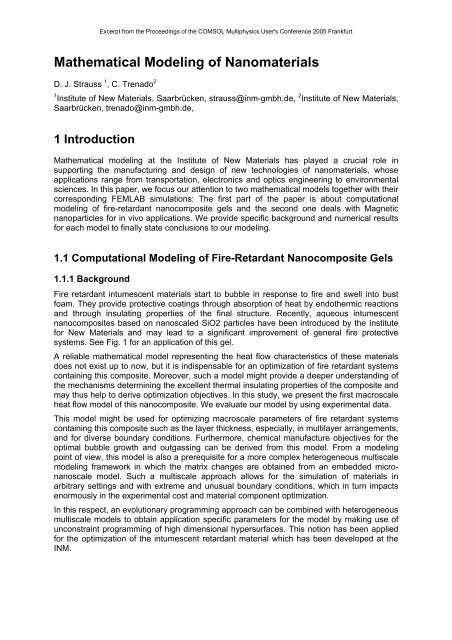
![[PDF] Microsoft Word - paper.docx - COMSOL.com](https://img.yumpu.com/50367802/1/184x260/pdf-microsoft-word-paperdocx-comsolcom.jpg?quality=85)
